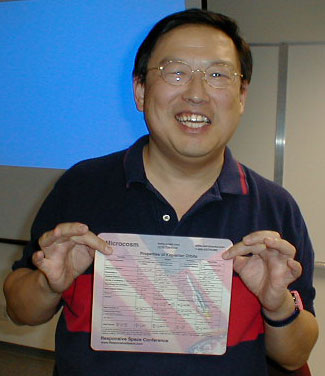Search this Site







Cruisin’ the Interplanetary Superhighway
by Steve Bartlett
Let it roll down the highway
—Bachman Turner Overdrive
We Southern Californians are always looking for a faster, easier way to get from here to there. Whether its taking Sepulveda Boulevard during rush hour to avoid traffic through "The Pass," buying a hybrid car so we can drive alone in the carpool lane, or wistfully looking at the end of the 710 freeway and wishing that it would go all the way through to the 210, we like to find a better way to get where we're going. And with the recent rise in gas prices, we've got even more incentive to make our commutes a little more efficient.
So it should come as no surprise that researchers at So. Cal's own NASA center, the Jet Propulsion Laboratory (JPL), have been looking for a better way to get where they're going: in this case, to other planets. They've discovered a means to get just about anywhere in the Solar System for very little fuel and called their approach the Interplanetary Superhighway. Dr. Martin Lo of JPL talked about the work he and his colleagues are doing on this innovative technique at an OASIS-sponsored lecture on May 15 in El Segundo.
 |
| Not just fuel-efficient, but beautiful to look at! (An artist's conception of the Interplanetary Superhighway.) Image courtesy of Martin Lo, JPL. |
Dr. Lo described the effort started centuries ago to solve the classic Three Body gravitational problem by mathematicians Euler and LaGrange. Euler and LaGrange solved part of the problem by identifying locations in space where the gravitational forces between two objects just balance out. These places, sometimes referred to as Lagrange points, are positions through which a spacecraft can pass with little propellant or remain in a stable orbit. (Note: One of the National Space Society's precursor organizations, the L5 Society, was founded with the intent to set up human colonies at the Lagrange points.) The SOHO solar research observatory is parked in one of these locations between the Earth and the Sun, where it can continually observe the Sun while relaying back its images on a continual basis.
The NASA researchers have used advanced dynamics theory and computer modeling to go beyond the early research and connect these points together in virtual subway tunnels in space. They allow a spacecraft to leave Earth orbit and, depending on how planetary bodies are aligned, fly to other planets or out of the Solar System entirely.
The first probe to exploit this technique, the ISEE 3 mission (later renamed the International Cometary Explorer), began its life in 1978 studying the interaction between the solar wind and the Earth. By setting the craft on a trajectory through one of these transit corridors, NASA sent it to rendezvous with Comet Giacobini-Zinner while consuming scant propellant.
 |
| Dr. Lo seems to like his gift — a Microcosm mouse pad with Keplerian orbital formulae. Ask us how you can get one of your own! |
Another robotic explorer, the Genesis mission, is using this approach to return samples of the solar wind to Earth. The craft's trajectory takes it from its collection position between the Earth and the Sun, though a Lagrange point on the far side of the Moon, and finally back to Earth. The mission will return its samples to a spot over the Utah Test and Training range on September 8.
Another spacecraft followed the Interplanetary Superhighway in the early 1970's, albeit inadvertently. When the Apollo 12 lunar mission boosted for the Moon in December 1969, its S-IVB upper stage went along for the ride. An engine firing put the Command/Service Module and the Lunar module into lunar orbit, but the S-IVB stage just kept going. The stage's trajectory took it into one of the "onramps" of the Superhighway, allowing it to escape from Earth orbit. It orbited the Sun for over three decades in a bizarre, curving, twisting path. Then, in 2002, astronomers discovered a small object entering a high Earth orbit. The object, dubbed J002E3, was found to be the same size and have the same spectrum as the Apollo stage. Its current orbit will carry it back onto the Interplanetary Superhighway in a few years and it will once again leave Earth's vicinity.
Dr. Lo described other, natural objects which have found their way onto the Superhighway, including Comet Gehrels 3 and Comet Oterma, both influenced by Jupiter's gravitational field and passing through its Lagrange points with the Sun. While talking about Jupiter, Lo described how a version of the Interplanetary Superhighway may be used to navigate around the Jovian system in the Jupiter Icy Moons Orbiter mission in the next decade.
With the advances in personal computing power, Superhighway trajectory analyses which once required a supercomputer can now be performed on a laptop, according to Lo. He envisions a time in the future when schoolchildren may be able to plot their way around the solar system for a hypothetical space mission.
Copyright © 1998-2005 Organization for the Advancement of Space Industrialization and Settlement. All Rights Reserved.